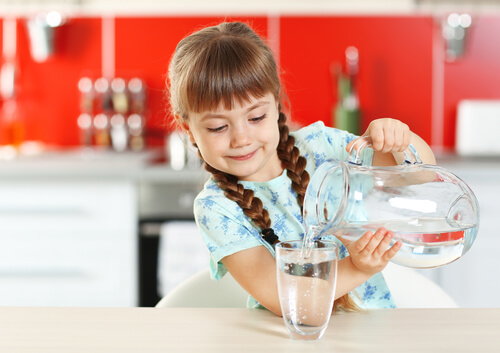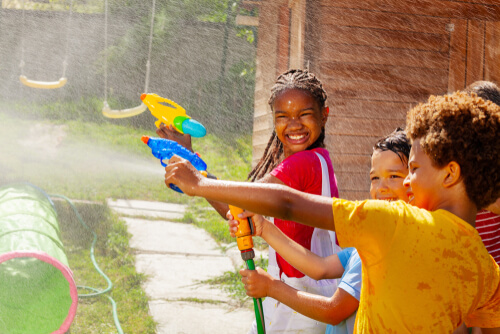20 Ways to Use Water to Support Communication
Feb 7, 2022 Tired of cutting out paper therapy sheets? Struggling to find play activities that create conversation? Determined to not spend a fortune on resources? You are in the right place! Good therapy is often the most simple and the most fun! But where to look?
First of all, there are a host of online platforms and apps such as Speech Blubs that are a simple and cost-effective place to start. Check out the website of your local speech and language service for resources and browse the Royal College of Speech and Language therapist (RCSLT) site for evidence-based information and strategies.
Second of all . . . you can use what you already have! It does not need to be fancy to be effective. To prove this, I will share below and in future posts, 20 areas of speech and language you can support using simple things at home, and this time it’s right at your fingertips! Water!
1. New vocabulary – e.g. ripples, tap, float, sink, wet, flow, flood, soak, waterfall
Whether it’s when you’re jumping in puddles, in the bath, washing hands, or during a water fight . . . there is a huge amount of new and exciting vocabulary to model (demonstrate) to your child. Introduce the vocabulary using single words, small phrases, and sentences to demonstrate the word, what it means, and how it can be used.
2. Verbs present tense – e.g. pour, splash, sprinkle, drip, dry, fill, paddle, spill
Water is a great tool to support verb development as you can interact with it in so many ways. Model verbs like the ones above during play and daily activities that involve water. Start modeling them as single words before including them in short sentences.

3. Verbs past tense – e.g. poured, splashed, sprinkled, dripped, filled, paddled, spilled
Once your child is confident with these verbs in the present form, you can model them as a past tense verb. Talk about what you have just done using the verbs as single words and then short sentences. You can support your child to understand that the verb is representing something that has happened in the past by waving/pointing back over your shoulder when you say the word. This simple sign supports their understanding of “past.”
4. Adjectives – e.g. warm, cold, wet, dry, deep, shallow, freezing, fast, slow
Water can be manipulated in play and day-to-day activities to demonstrate a great range of adjectives. Explore and experience the adjectives with your child, e.g. fill different cups with different temperature water to feel and discuss, at bath time let the water out slowly to talk about deep and shallow water, get the hose out in the garden to make different bits of the garden wet or dry, pour water from jugs into a sink to play with water running fast or slow.
5. Positional language – in, out, under, on
Play and model positional language with your child when exploring water. A rubber duck might be “on” the water, while the frog might be “under” the water, while the bear is “out of the water,” etc.
6. Ready, steady, go!
Model “Ready, Steady, Go!” during water games in the garden or bath. Withhold the water, e.g. by turning off the hose, turning off the tap, etc. then model “ready . . . steady . . . GO!” and release the water. If you make the activity fun and exciting it will motivate your child so say/indicate “go!” on their own.
7. Request words e.g. “more” and “again”
To step up the task above you can replace “ready, steady, go!” with request words like “more” or “again.”
8. Capacity – full, empty, half
Explore words that describe capacity using water and different containers. Model language for the size and capacity of the containers e.g. “the bottle is half full,” “the cup is empty,” and “the jug is too small and it is overflowing!” Add food colouring or glitter to the water to make the activity extra motivating.

9. Real world play
Play is the gateway to language and communication. Encourage real-world play by creating opportunities to play with water in a functional way, e.g. set up their own handwashing station in the garden, set up a bowl where they can wash their own snack, wash their dolls hair in the shower, or put water in their toy teapot for them to pour.
10. Teach water as a category
Whether it is water transport vs. land transport, land animals vs. water animals, water activities vs. land activities, you can talk and sort things during play, e.g. introduce toy animals into the bath and work out which ones can come in the water and which ones stay on the side . . . . For example, “the frog can come in because he can swim,” etc.
11. Water theme “What’s in the bag?”
Print out, draw, or write different water items on different pieces of paper and put them in a bag. Take turns to draw an item and describe it to your partner for them to guess e.g. a river . . . it is fast, it goes down a hill, it goes under a bridge. The sea . . . it is big, salty and you swim in it at the beach. A pond . . . it is small, still, in the garden and frogs live in it. Bath . . . it is small, still, in the house, feels warm, and has bubbles. Waterfall . . . it is fast, it is water dropping from a high height, and is found on a mountain or rainforest. Swimming pool . . . it is big, still, rectangle, inside, and we swim in it.
12. Blowing bubbles
Have fun and make a mess! Fill up different containers with water and blow into the water using a straw to make bubbles. Explore different containers, different amounts of water, and different blowing strengths, and chat about the differences you see. Add food coloring for extra fun!
Boost Your Child’s Speech Development!
Improve language & communication skills with fun learning!

13. Comparatives – e.g. hot, hotter, the hottest. cold, colder, the coldest. deep, deeper, the deepest.
Explore comparatives with your child describing and comparing different water. Run water at different temperatures, compare ice and water, pour different water depths in the bath, and add “-er” and “-est” to the vocabulary you are using to compare the types of water.
14. Imaginary play
Play is a great tool to unlock language. Use water to support your child’s imaginative play, e.g. pretending the water is magic potions, lava from a mountain, hot chocolate from their cafe, that ice is a type of special diamond, and water from the hose is fire breathed from a dragon.
15. Social interaction- e.g. water fights, joint baths, paddling pools
Water is fun! So put the paper resources away and get creative! Have water fights in the garden, fill water balloons, go swimming, create a pond together . . . play together as a family in a way that creates connection and therefore communication.

16. Sensory – Ice, colored water
Explore water temperatures, feel ice and watch it melt, float in a paddling pool, add colour and glitter. Water is a great sensory tool for your child to have a chilled timeout or learn new and interesting ideas and language.
17. Sharing
Water is a fun functional tool to work with. Use water to discuss sharing, fairness, and whether people have the same or different, e.g. everyone has a cup. Your child can practice pouring everyone a drink while the adult can model language around the “same” vs. “different” using the water level in the cups as a visual.
18. Small world play
Include water in your child’s small world play, e.g. create a river for them to drive their cars through, a lake for their lego castle, a swimming pool for their Barbies, or a pond for their animals to drink from. Water brings small world play to life, letting their characters drink, swim, wash, paddle, etc. Model the language for this alongside their play.
19. Science vocabulary – e.g. melt, evaporate, boil, lake, rainfall, H2O, hydration
Explore, research and talk about water in the world. Support science vocabulary by exploring through books, the internet, and activities.

20. Everyday routines – e.g. washing hands, brushing teeth, showering, washing food.
Water is in our day to day routines. No time to set up activities? No worries! Just talk about the water your child comes across as they go about their normal activities while modeling related vocabulary. Do they like their bath hot or cold? How could they make it hotter or colder if they wanted? Where does water come from when washing your hands? How does it get to the tap? As a drink, is water good for our bodies? What does feeling thirsty mean?
Whether it is small 1:1 chats in the bathroom before bed or large family waterfights, water is a simple, exciting, and language-rich topic to explore! Have a go, make a start, and have fun!
